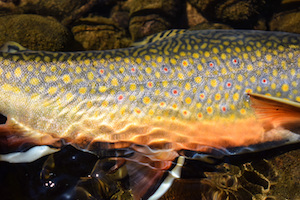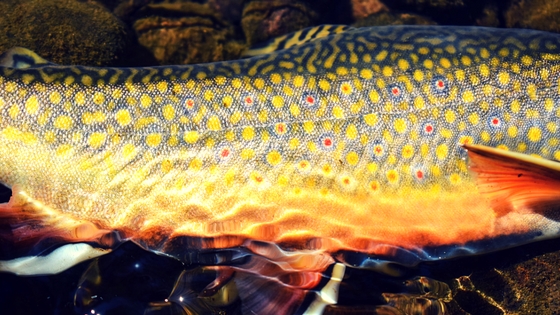Brook Trout Reproduction

 colors of the brook trout spawning
colors of the brook trout spawning
Brook Trout are very finicky fish. They require a specific water temperature, crystal, clear water and no pollution or human encroachment.
As it turns out, they’re even more fussy when it comes to spawning. If the conditions are not perfect, they won’t spawn at all.
This a run down of the conditions required. If any of these are not present, the Brook Trout will fail to spawn.
- Brook Trout spawn over gravel or sandy lake beds. The water depth is not more than about 6 feet/2 metres.
- When finding these conditions, they’ll then seek out an underwater spring or an upwelling* water leeching through the gravel or sand.
- If the temperature is above 68°F/20°C, spawning will not occur. Their ideal spawning temperature range is 50°F to 56°F/10°C to 13°C degrees.
Spawning usually starts in October and continues until Fall when the ice has left waterways and the temperature moves above 50°F/10°C.
The female Brook Trout leaves her eggs in a depression over a spring or upwelling of water. The depression is created by using the brook trout’s tail and they use their tail to cover it up as well.
Covering the eggs helps to protect them from predators, environmental shock and keeps a constant flow of water over them.
The eggs incubate for 2 to 3 months before hatching into what’s called sac fry.
Brook Trout are Fussy
In Algonquin Park Ontario, many of the lakes and rivers have the perfect lake bottoms, which are sandy with gravel and small rocks. But if there’s not an upwelling of water, they will not spawn. Even if the water temperature is perfect.
Being as fussy as the Brook Trout are over environmental conditions is not good for survival.
Changes in climate and the environment, by both human and natural conditions do not bode well for survival of the species. Those species that have shown the ability to adapt to changing conditions are those that are able to survive.
Brook Trout Survival
Putting a greater strain on the Brook Trout is a climate that continues to warm in the northern hemisphere. While they’re not endangered now, they are a species to be watched as the climate continues to warm this century.
Hybrid Brook Trout
Brook trout have been known to breed with Brown Trout. The offspring are called Tiger Trout.
Tiger trout are a rare natural occurrence and result in sterile offspring. They are popular with many stocking programs due to their fast growth.
*upwelling: Deep, cold, nutrient rich water rises (wells up) towards the surface and displaces surface waters. A nutrient rich natural spring.


